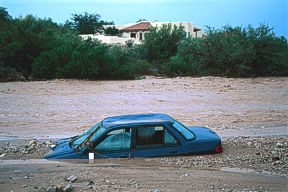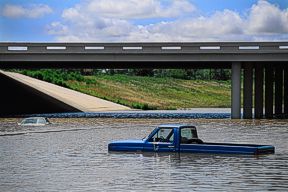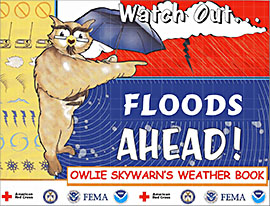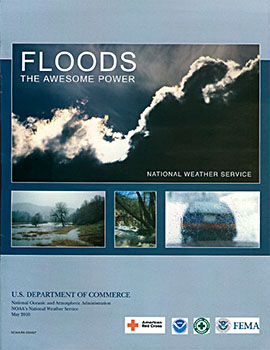
More deaths occur from flooding than any other weather hazard except heat. Why? Because most people fail to realize the power of water. Just six inches of fast-moving flood water can knock you off your feet, 12 inches can carry away a car, and 24 inches can pick up an SUV or truck.
While the number of fatalities can vary dramatically from year to year, the national 30-year average for flood deaths is 88. That compares with a 30-year average of 41 deaths for lightning and 68 for tornadoes.
National Weather Service data also shows:
- Nearly half of all flash flood fatalities are vehicle-related,
- The majority of victims are males, and
- Flood deaths affect all age groups.

Most flash floods are caused by slow moving thunderstorms, thunderstorms that move repeatedly over the same area, or heavy rains from tropical storms and hurricanes. These floods can develop within minutes or hours depending on the intensity and duration of the rain, the topography, soil conditions, and ground cover.
Flash floods can roll boulders, tear out trees, destroy buildings and bridges, and scour out new channels. Rapidly rising water can reach heights of 30 feet or more. Furthermore, flash flood-producing rains can also trigger catastrophic debris flows and mudslides.
Occasionally, floating debris or ice can accumulate at a natural or man-made obstruction and restrict the flow of water. Water held back by the ice jam or debris dam can cause flooding upstream, and if the obstruction should suddenly release, subsequent flash flooding can occur downstream.
TURN AROUND DON'T DROWN®

Whether you are driving or walking, if you come to a flooded road, Turn Around Don't Drown!
Not only will you not know the depth of the water, you also won’t know the condition of the road under the water. And never go around barriers that are in place to warn of flooding.
Of the three deaths which occurred as a result of the Fort Worth tornado, March 28, 2000, one death was due to flooding. The man who drowned was a passenger in his girlfriend’s car and didn’t understand the dangers of flood waters.
Flooding was a common occurrence at this location during heavy rain, and the danger was well marked. The driver entered the flooded portion of the road, but became frightened as the water rose higher and higher around her vehicle. She backed out to higher ground. The passenger, however, said the water was NOT too deep and he would prove it by walking across to the other side. He never made it.
To stay safe from flash flooding, follow these safety rules:
- Monitor the NOAA Weather Radio or your favorite news source for vital weather-related information.
- If flooding occurs, get to higher ground and out of areas subject to flooding. This includes dips, low spots, canyons, washes, etc.
- Avoid already flooded and high velocity flow areas. Do not attempt to cross flowing streams. If you enter a flowing stream and the water gets above your knee, TURN AROUND DON'T DROWN.
- When driving, be aware that the road bed may not be intact under flood waters. Turn around and go another way. NEVER drive through flooded roadways! If your vehicle stalls, leave it immediately and seek higher ground. Rapidly rising water may engulf the vehicle and sweep you and your occupants away.
- Do not camp or park your vehicle along streams and washes, particularly during threatening conditions.
- Be especially cautious at night when it is harder to recognize flood dangers.
We say "Follow these safety rules" and most folks say "Yeah, yeah, whatever. It's not going to happen to me." A simple Internet search of flash flood victims (with some seen from inside the vehicle) will show you the reason to just TURN AROUND DON'T DROWN. Learn more about flash flooding.




